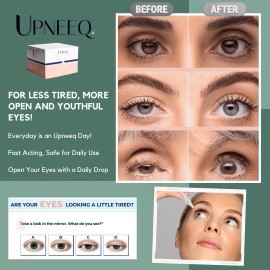
UPNEEQ® $200/Box
Experience the eye-opening possibilities with Upneeq! If your eyes look “tired” or “sleepy,” you may have a condition called acquired blepharoptosis (also known as acquired ptosis or low-lying lids). Upneeq is the only FDA-approved prescription eyedrop for acquired ptosis (low-lying lids) that lifts your upper eyelids to open your eyes.
Most patients in clinical trials had a lift in their eyelids in as little as 2 hours. 84% of patients had some level of improvement; 74% of patients had more than 50% improvement.
Upneeq also has helped patients with acquired ptosis see more – on the first day of treatment! 87.8% of patients had some level of improvement; 40.8% of patients had at least 50% improvement on Day 14 (2 hours after applying Upneeq).
UPNEEQ® FAQ'S
IMPORTANT SAFETY INFORMATION
What is UPNEEQ?
UPNEEQ® (oxymetazoline hydrochloride ophthalmic solution), 0.1% is a prescription eyedrop used to treat acquired blepharoptosis (low-lying lids) in adults.
What warnings and precautions are associated with UPNEEQ?
- Low-lying lids may be related to conditions such as stroke and/or brain aneurysm, Horner syndrome, myasthenia gravis, loss of the ability to move eye muscles, eye infection and eye tumors. Tell your doctor if you have any of these conditions.
- UPNEEQ is a type of medication that may affect your blood pressure. If you have heart disease, uncontrolled high or low blood pressure, or feel faint at rest or when quickly standing up, you should call your doctor if your symptoms get worse.
- Patients with reduced blood flow to the brain or heart, or patients who experience eye or mouth dryness due to an immune system disorder (Sjögren’s syndrome), should use care when taking UPNEEQ. Call your doctor immediately if you feel your symptoms may be getting worse.
- UPNEEQ may increase the risk of eye pressure due to fluid buildup (angle-closure glaucoma) in patients with untreated narrow-angle glaucoma. Call your doctor immediately if you feel increased pressure in your eye after using UPNEEQ.
- Do not let the tip of the UPNEEQ vial touch your eye or any other surface. This can help prevent eye injury or contamination. Each UPNEEQ vial is for one-time use and should be discarded after being used.
What are the most common side effects of UPNEEQ?
The most common adverse reactions with UPNEEQ (occurring in 1-5% of patients) were eye inflammation, eye redness, dry eye, blurred vision, eye pain at time of use, eye irritation, and headache.
What should my doctor know about before prescribing me UPNEEQ?
- Your doctor should review your full medical history before prescribing UPNEEQ.
- UPNEEQ belongs to a class of medication (alpha-adrenergic agonists) that may affect your blood pressure. Use UPNEEQ carefully if you currently take an alpha-adrenergic agonist medication to treat heart disease or an enlarged prostate. Patients taking beta-blockers, or other medications to treat hypertension or an abnormal heartbeat, should also be careful when using UPNEEQ.
- Patients who use a certain class of antidepressant medication (monoamine oxidase inhibitors) should also be careful when using UPNEEQ, as it may affect the way your body absorbs the medication.
These are not all of the possible side effects of UPNEEQ. Tell your doctor if you have any side effect that bothers you or does not go away. Call your doctor for medical advice about side effects.
Visit us at:
6400 Rothman Rd.
Fort Wayne, IN 46835
&
122 W. Wayne Street Fort Wayne, IN 46802
&
605 W. 275 N.
Angola, IN 46703
(Club Fitness Facility Downstairs)
(260) 399-5874
info@thedowntownspa.com
Painless Laser Hair Removal
We offer several Facials and Aesthetic Services to help you achieve your desired look! Learn more about each treatment below.
Botox Dypsort XEOMIN
Botox, Dysport and XEOMIN are all types of botulinum toxin injections that have been FDA approved for treating fine lines and wrinkles. Overall, they are very similar. Our medical provider will sit down with you to find the right product and dosage to fit your needs. Our goal is to make sure your expectations are met and we have reviewed with you the differences in products, costs and how long the products will last. Learn more here.
Dermal Fillers
We offer a range of FDA approved facial fillers including Juvederm, Restylane, Radiesse and Juvederm Voluma. Injectable dermal fillers can plump lips, remove wrinkles, fill in facial creases as the laugh lines, sculpt the chin and jawline, chin augmentation and fill cheek depressions. Most of our fillers consist of hyaluronic acid which is a natural substance found in your body. We will create a treatment plan with you to give you natural looking results. Learn more here.
Sculptra
This treatment activates your skin’s natural power to revitalize collagen production for a more youthful appearance. It is the only FDA-approved biodegradable injectable poly-L-lactic acid collagen biostimulator that works deep in the skin to improve its inner structure to smooth deep facial wrinkles, such as smile lines and add plumpness to shallow areas. Learn more here.
KYBELLA
Kybella is an injectable used to improve the appearance of moderate to severe fat below the chin – commonly known as the double chin. Kybella is the first-of-its-kind, nonsurgical option to permanently destroy fat cells in the treated area improving the chin profile. A series of treatments are individually tailored to you and your aesthetic goals. Learn more here.
Latiesse
Want fuller, longer, darker lashes in 16 weeks? Latisse is a FDA approved prescription treatment for inadequate lashes. Learn more here.
Chemical Peels
A Chemical Peel removes layers of the skin to reveal more youthful looking skin. They can reduce or improve the appearance of fine lines and wrinkles, acne, scars, uneven skin tones and other skin imperfections. The treatment consists of an innovative, in-office peel followed by an at-home treatment to combat the signs of aging + skin discoloration. The 3 Step Chemical Peels utilizes a blend of exfoliants, retinol and multi-action agents to help improve skin health and treat many signs of aging, while providing antioxidant protection. Learn more here.
Microchanneling Facial
Microchanneling is a medical treatment that stimulates the body’s natural ability to produce collagen growth, elastin and other building blocks of healthy skin – using PepFactor and Vitamin C to help brighten the appearance of hyperpigmentation, facial scaring, uneven skin tone and dimish the appearance of fine lines and wrinkles. Learn more here.
Botox Facial
The ultimate facial! Smooth fine lines and wrinkles, decrease the appearance of hyperpigmentation and age spots, brighten dull skin, shrinks pore size and tightens skin. Botox Facial is a sterile, surgical grade stainless steel single use microchanneling technology, designed to deliver a specific amount of a drug or biologic, just under the dermis. We can create a custom combination just for your skin – including Botox and Fillers, Vitamin C, Pepfactor, Hyaluronic Acid and Ascorbic Acid. Learn more here.
We offer several Facials and Aesthetic Services to help you achieve your desired look! Learn more about each treatment below.
Botox Dypsort XEOMIN
Botox, Dysport and XEOMIN are all types of botulinum toxin injections that have been FDA approved for treating fine lines and wrinkles. Overall, they are very similar. Our medical provider will sit down with you to find the right product and dosage to fit your needs. Our goal is to make sure your expectations are met and we have reviewed with you the differences in products, costs and how long the products will last. Learn more here.
Dermal Fillers
We offer a range of FDA approved facial fillers including Juvederm, Restylane, Radiesse and Juvederm Voluma. Injectable dermal fillers can plump lips, remove wrinkles, fill in facial creases as the laugh lines, sculpt the chin and jawline, chin augmentation and fill cheek depressions. Most of our fillers consist of hyaluronic acid which is a natural substance found in your body. We will create a treatment plan with you to give you natural looking results. Learn more here.
Sculptra
This treatment activates your skin’s natural power to revitalize collagen production for a more youthful appearance. It is the only FDA-approved biodegradable injectable poly-L-lactic acid collagen biostimulator that works deep in the skin to improve its inner structure to smooth deep facial wrinkles, such as smile lines and add plumpness to shallow areas. Learn more here.
KYBELLA
Kybella is an injectable used to improve the appearance of moderate to severe fat below the chin – commonly known as the double chin. Kybella is the first-of-its-kind, nonsurgical option to permanently destroy fat cells in the treated area improving the chin profile. A series of treatments are individually tailored to you and your aesthetic goals. Learn more here.
Latiesse
Want fuller, longer, darker lashes in 16 weeks? Latisse is a FDA approved prescription treatment for inadequate lashes. Learn more here.
Chemical Peels
A Chemical Peel removes layers of the skin to reveal more youthful looking skin. They can reduce or improve the appearance of fine lines and wrinkles, acne, scars, uneven skin tones and other skin imperfections. The treatment consists of an innovative, in-office peel followed by an at-home treatment to combat the signs of aging + skin discoloration. The 3 Step Chemical Peels utilizes a blend of exfoliants, retinol and multi-action agents to help improve skin health and treat many signs of aging, while providing antioxidant protection. Learn more here.
Microchanneling Facial
Microchanneling is a medical treatment that stimulates the body’s natural ability to produce collagen growth, elastin and other building blocks of healthy skin – using PepFactor and Vitamin C to help brighten the appearance of hyperpigmentation, facial scaring, uneven skin tone and dimish the appearance of fine lines and wrinkles. Learn more here.
Botox Facial
The ultimate facial! Smooth fine lines and wrinkles, decrease the appearance of hyperpigmentation and age spots, brighten dull skin, shrinks pore size and tightens skin. Botox Facial is a sterile, surgical grade stainless steel single use microchanneling technology, designed to deliver a specific amount of a drug or biologic, just under the dermis. We can create a custom combination just for your skin – including Botox and Fillers, Vitamin C, Pepfactor, Hyaluronic Acid and Ascorbic Acid. Learn more here.
Skinwave Facial
Your content goes here. Edit or remove this text inline or in the module Content settings. You can also style every aspect of this content in the module Design settings and even apply custom CSS to this text in the module Advanced settings.




